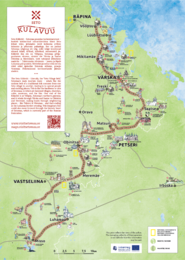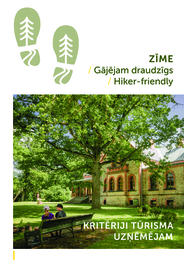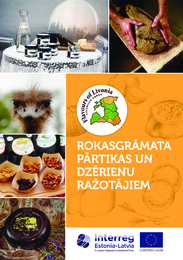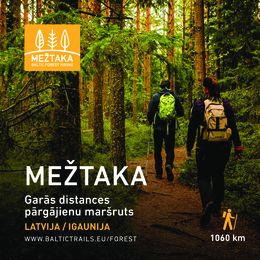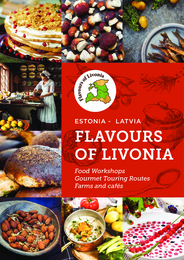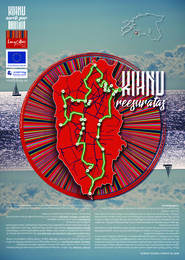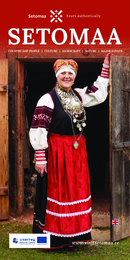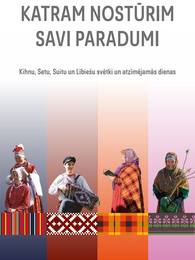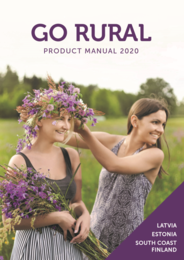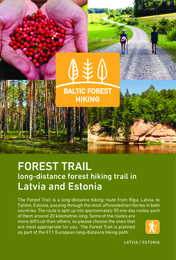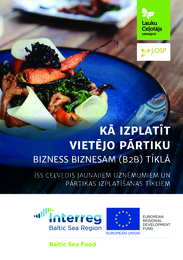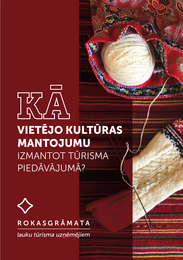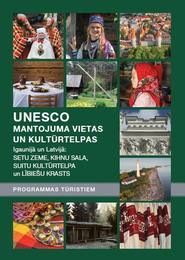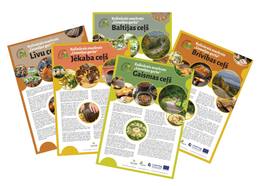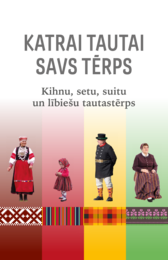Publications
Publications of "Lauku ceļotājs"
Our publications in English: accommodation catalogue „Country Holidays”, maps and travel guides for touring Latvia by car, bike, boating or hiking offer practical information and are most useful to plan and experience your holidays in Latvia. We have inspected all sites and tested all routes which are described. See below the details about contents of each of our publications.
To order the publications please send a request to the e-mail: lauku@celotajs.lv. You can pay for the publication with credit card or bank transfer. To read regular news about our new publications, please follow this link.
| Publication | Description |
|---|---|
Route map "Seto Külävüü"The Seto Külävüü - literally, the Seto Village Belt, Setomaa's main tourism route - winds like the undone belt of a traditional folk costume from one Seto village to another, leading is to special people and exiting places. |
|
"Hiker-friendly" criteriaHiking tourists are in close contact with the region in which they are and find it particularly important to feel that they are welcome and understood. This emotion is primarily created by visual information such as information stands, directional signs, appropriate information materials, thematic books and guidebooks. Hikers are expecting to find necessary products at local shops, as well as knowledgeable and helpful people who want to assist them. In many places where hikes are popular, there are signs or stickers which read “Hiker-Friendly”. This may be a part of a certification programme, and the signs are only received by venues which meet the relevant criteria. The signs may also be used by responsible tourism organisations, with businesses being free to choose whether or not they want to post the sign. In other cases, this can be the initiative of businesses as such. The “Hiker-Friendly” sticker or sign is an effective way of demonstrating that the target audience is welcome. The signs are well-known all over the world, and travellers who spot them clearly understand that their needs will be understood and that there will be someone who will be prepared to share valuable information. If a tourism product is to be successful, involved parties must have the same hospitality quality principles. The criteria can help tourism companies to orient themselves. General criteria are appropriate for any tourism service provider, while criteria for accommodations only apply to accommodations. The “Hiker-Friendly” sign is available to any service providers for tourists in the Baltic States that want to be “friendly” toward hikers and to offer the relevant services to the target audience. The sign is not linked to any specific pathway or route. The “Hiker-Friendly” criteria are guidelines for tourism companies. Some of them are mandatory, while others are recommended. A company which wants to get the sign must satisfy at least 75% of the mandatory criteria. |
|
A Guide for Food and Beverage Producers of the "Livonian Culinary Route"This guide summarizes tips for food and beverage manufacturers that encourage them to present their product and its story in a thoughtful way, and to think about how to make an emotional connection with the consumer of the origin of the product. Inspired stories of small producers in Latvia and Estonia are good examples of tourism development. The tips and advice in this booklet can expand your knowledge of the insights into the food preparation process and how to make this food adventure. Involvement in different areas of culinary tourism creates many direct contacts with consumers. Direct and enthusiastic product reviews from food lovers are extremely valuable and enrich the daily life of the small producer. The guide is available electronically (in PDF format) in Latvian and Estonian. Guide for Entrepreneurs prepared within the framework of the project “Livonian Culinary Route”, implemented within the framework of the Interreg Estonia-Latvia program from the European Regional Development Fund. This publication reflects the views of the author. The managing authority of the programme is not liable for how this information may be used. |
|
Forest Trail brochure and mapThe brochure introduces the long-distance hiking route FOREST TRAIL, which passes ~ 1060 km through the forests of Latvia and Estonia, from Riga to Tallinn. In Latvia, FOREST TRAIL runs through the Gauja National Park, the Northern Gauja Forestlands and Veclaicene. In Estonia, FOREST TRAIL runs through the Haanja uplands, the Setomaa un Peipsimaa regions and further along the coast of Northern Estonia - to Tallinn. The route along the Estonian part includes the Lahemaa National Park and the coast of Northern Estonia, which is the land of the most impressive rocks, waterfalls and clints in the Baltic States. You will recognize FOREST TRAIL as Mežtaka in Latvia and as Metsa Matkarada in Estonia. |
|
Touroperator manual "Flavours of Livonia"This brochure includes thematic visits and farm programs as well as guided tours in Latvia and Estonia. They are designed for individual travelers and / or tourist groups and can be easily adapted to the needs of travelers. You can learn more about farms where you can get to know the unique local foods directly from the producers, watch the cooking or take part in the process, dine on home-cooked traditional food or enjoy local wine and beer. |
|
Tourism map "Kihnu Reesuratas"In the tourism map "Kihnu Reesuratas" (Kihnu Travel Wheel) there is available the round route for discovering the cultural and natural sights on Kihnu island by foot, with a bicycle or even with a nostalgic sidecar. Kihnu Travel Wheel introduces the cultural space, landscapes and sea views acknowledged by UNESCO to the visitors. |
|
Brochure "Setomaa"Brochure introduces with country and people, culture, handicraft, nature, major events of Setomaa region. |
|
Katram nostūrim savi paradumi (Kihnu, Setu, Suitu un Lībiešu svētki un atzīmējamās dienas)Šī grāmata ir sava veida turpinājums 2019. g. pavasarī iznākušajai grāmatai „Katrai tautai savs tērps“. Ja iepriekšējā grāmatā iepazīstinājām ar četru dažādu tautu – setu, kihniešu, suitu un lībiešu jeb līvu – tautastērpiem, tad šajā izdevumā iepazīstināsim ar šo tautu svinamajām dienām, kā arī svarīgākajiem ikgadējiem kultūras notikumiem. Mūsdienās cilvēki jau sen vairs nedzīvo tikai pēc baznīcas kalendāra. Gan kihniešiem, gan setiem, gan suitiem gan lībiešiem ir daudz svinamu dienu un pasākumu, kas ir radušies samērā nesen, bet jau kļuvuši par nozīmīgiem kultūras notikumiem. Ja baznīcas svētki ir vairāk domāti savējiem un tūristi tajos netiek īpaši gaidīti, tad uz jaunizveidotajiem pasākumiem viesi no citurienes ir laipni lūgti. Grāmata ir pieejama:
Grāmata tika izdota Igaunijas-Latvijas Programmas no Eiropas Reģionālā attīstības fonda projekta “Mazo etnisko kultūrtelpu attīstība un popularizēšana kā tūrisma galamērķis” ietvaros. Augstākminētā informācija atspoguļo autora viedokli. Programmas vadošā iestāde neatbild par tajā ietvertās informācijas iespējamo izmantošanu. |
|
"Go Rural" product manual 2019 - Latvia/Estonia/South coast FinlandThis manual is aimed at helping you discover rural destinations in the South of Finland, Estonia and Latvia beyond traditional touristic routes. The programmes and sites in this manual are based around small-scale accommodation, open farms, local producers, living traditions and sincere people. The people here have a close relationship with their natural surroundings and annual cycle. Each season has its own specific activities like mushrooming, berry picking, collecting herbs, ice-fishing and different agricultural jobs as well as traditional and seasonal celebrations. The countries are a haven for the tourist who loves nature, respects traditions and would like to experience them and their cultures more deeply. Behind this manual there is a team of professional countryside tourism organisations and tour operators. For many years we have carried regular inspections of our accommodation and sites, have closely cooperated with national parks and nature experts, researched and developed new routes. In this brochure we present example products based on rural experiences such as visits to country farms, hands-on workshops, tours of UNESCO World Heritage Sites, stays at spa hotels, and opportunities to get closer to nature or to live like locals. Some model itineraries for touring the three countries are presented. All of these can be linked with the traditional touristic routes and city experiences to bring more variety and attraction. Travelling options between the countries are shown by air, ferries and bus. A list of tour operators that can help to arrange tours and services group and individual customers is provided in this manual. |
|
Long distance hiking trail "The Forest Trail" info-pageThe Forest Trail is a long-distance hiking route from Rīga, Latvia, to Tallinn, Estonia, passing through the most afforested territories in both countries. The route is split up into approximately 50 one-day routes, each of them around 20 kilometres long. Some of the routes are more difficult than others, so please choose the ones that are most appropriate for you. The Forest Trail is planned as part of the E11 European long-distance hiking path. |
|
Kā izplatīt vietējo pārtiku Bizness-Biznesam (B2B) tīklā - rokasgrāmata jaunajiem uzņēmumiem un pārtikas produktu izplatīšanas tīkliemŠis izdevums ir kā rokasgrāmata B2B izplatīšanas modeļa attīstības veicināšanai. Tā mērķis ir iedvesmot Jūs veidot vietējo pārtikas izplatīšanas tīklu vai uzņēmumu, veicināt produktu mārketingu un sniegt idejas sākuma posmam. Dažādus risinājumus B2B modeļa ieviešanā un attīstībā piedāvā desmit projekta dalībvalstu – Dānija, Igaunija, Krievija, Latvija, Lietuva, Norvēģija, Polija, Somija, Vācijas un Zviedrija – labākā pieredze. Rokasgrāmatas mērķa grupa ir vietējie pārtikas ražotāji un piegādātāji, kā arī vietējās pārtikas tirdzniecības tīkli. Projekta uzdevums ir radīt un veicināt jaunu tirdzniecības kanālu izveidošanu un attīstību uzņēmumiem bizness biznesam vidē (B2B), izmantojot maza mēroga vietējos pārtikas tīklus, attīstot sadarbību un palielinot produktu vērtību pēc iespējas īsākā piegādes ķēdē. Tā mērķis ir arī iedvesmot esošos vietējos pārtikas ražotājus un izplatītājus, kas jau pārdod savus produktus patērētājam (B2C), attīstīt B2B tirdzniecības modeli. Elektroniski (PDF formātā) rokasgrāmata pieejama angļu un latviešu valodās, drukātā versija latviešu valodā pieejama Lauku ceļotāja birojā, Kalnciema ielā 40.
Šīs materiāls finansēts projekta "B2B izplatīšanas modelis, lai atbalstītu vietējos pārtikas ražotājus Baltijas jūras reģiona lauku teritorijās" no Interreg Baltic Sea Region programmas. |
|
Kā vietējo kultūras mantojumu izmantot tūrismā?Rokasgrāmatā tiek sniegti prakstiski ieteikumi, kā izmantot vietējā kultūras mantojuma potenciālu, kādas sadarbības formas veidot, lai to pārvērstu tūrisma produktā. Tiek apskatītas mārketinga iespējas, ņemot piemērus no četriem spilgtiem etnisko kultūru reģioniem – Suitu novads un Līvu krasts Latvijā, Setu zeme un Kihnu Igaunijā. Šī rokasgrāmata tapusi Igaunijas–Latvijas programmas no Eiropas Reģionālā attīstības fonda projekta “Mazo etnisko kultūrtelpu attīstība un popularizēšana kā tūrisma galamērķis “UNESCO – tūrisms”” ietvaros.
|
|
Programmes for tourists: UNESCO INTANGIBLE CULTURAL HERITAGE OF HUMANITY Ethnographic Regions of ESTONIA - Setomaa, Kihnu Island LATVIA - Suiti Land, Livonian CoastThe programmes allow visitors to experience four unique and different ethnographic regions where authentic traditions are still part of peoples’ everyday life. They are: Setomaa region (Estonia), Kihnu island (Estonia), Suiti cultural space (Latvia) and the Livonian coast (Latvia) presenting UNESCO heritage in the following ways:
|
|
Livonia Regional LeafletsRegional leaflets have been published to make it easier and more enjoyable for tourists to travel through the regions of Latvia and find out about the culinary traditions and places to visit in the area. Five leaflets describes culinary heritage and history of each region and includes maps with the routes around 36 objects of Livonian Culinary Route and other attractions. Routes can be done in any possible way - by car, bike or hiking. Head to Kurzeme on the Freedom and Jacob roads to try delicious Sklandrausi pies or learn how to cook traditional Kurzeme dishes with Suiti wives. In Vidzeme you will be offered freshly baked rye bread. There you can follow the path of grain along the Baltic and Light roads. But the Liv road will take you through almost the entire coast of Latvia, tempting the with smell of freshly prepared fish. |
|
Katrai tautai savs tērps (Kihnu, setu, suitu un lībiešu tautastērps)Grāmatā ir sniegts īss pārskats par četru etnisko grupu – setu, kihniešu, suitu un lībiešu – tautastērpiem. Setiem, kihniešiem un suitiem, salīdzinot ar kaimiņiem, savu tautas tērpu valkāšanas un darināšanas tradīcija ir ļoti labi saglabājusies un joprojām tiek turēta vērtē. Ievērības cienīgi ir arī tas, ka visu četru kultūrvēsturisko novadu tradicionālie tērpi stipri atšķiras no kaimiņu tautastērpiem. Par iemeslu uzskatāma būtiski citāda kultūra vai vēsturiskais fons. |
|
